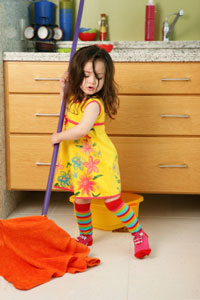Household Cleaning Products – one of the leading sources of pediatric poisoning
New National Study Finds Decrease in Pediatric Injuries Associated with Household Cleaners Children younger than 6 years still at high risk of poisoning
 Every year in the United States, there are more than 1.2 million poison exposures among children younger than 6 years. In recent decades, household cleaning products have consistently been one of the leading sources of pediatric poisoning. A new study conducted by the Center for Injury Research and Policy of The Research Institute at Nationwide Children’s Hospital found that from 1990-2006, an estimated 267,269 children younger than 6 years were treated in U.S. hospital emergency departments for injuries attributable to household cleaning products. During the 17-year study period, researchers noted a 46 percent decrease in the number of injuries.
Every year in the United States, there are more than 1.2 million poison exposures among children younger than 6 years. In recent decades, household cleaning products have consistently been one of the leading sources of pediatric poisoning. A new study conducted by the Center for Injury Research and Policy of The Research Institute at Nationwide Children’s Hospital found that from 1990-2006, an estimated 267,269 children younger than 6 years were treated in U.S. hospital emergency departments for injuries attributable to household cleaning products. During the 17-year study period, researchers noted a 46 percent decrease in the number of injuries.
Data from the study, being released online August 2 and appearing in the September issue of Pediatrics, show that most of the household cleaner-related injuries were poisonings, with children ages 1-3 years accounting for the majority (72 percent) of the injuries. Bleach was the cleaning product most commonly associated with injury (37.1 percent). While approximately one-third of the injuries occurred through contact with the cleaning product, the more frequent means was ingestion (62.7 percent), and spray bottles were the most common storage container (40.1 percent).
“Interestingly, spray bottles were the only major storage source that increased over the study period,” said study lead author Lara McKenzie, PhD, principal investigator at the Center for Injury Research and Policy at Nationwide Children’s Hospital. “Although rates of household cleaner-related injuries from regular bottles and original containers decreased during the study period, spray bottle injury rates remained constant. This area is worthy of further research.”
The good news is that the number of injuries decreased almost by half during the study period, but the bad news is that there were still nearly 12,000 children younger than 6 years who suffered injuries from household cleaning products in 2006.
“Young children are curious about their surroundings and tend to explore their environment by putting things in their mouths,” said Dr. McKenzie, also a faculty member of The Ohio State University College of Medicine. “This general sense of inquisitiveness, combined with increased mobility, the ubiquitous nature of household cleaning products and the ease of accessibility, place young children at high risk of injury.”
Parents and caregivers must do their part to prevent childhood poisonings. According to Heath Jolliff, DO, associate medical director of the Central Ohio Poison Center at Nationwide Children’s Hospital, parents should store poisonous substances in locked cabinets, out of sight and reach of children.
“It’s important to only purchase cleaners with child-resistant packaging, keep all products in their original containers and properly dispose of leftover or unused products,” Dr. Jolliff, also a faculty member at OSU College of Medicine, said.
Parents should also know what to do if they suspect their child has come in contact with a poison. Dr. Jolliff advises to immediately contact the Poison Center at 1-800-222-1222 (this national number will direct callers to their local Poison Center), unless the child is unconscious, not breathing, or having seizures, in which case parents should call 9-1-1.
This is the first published study using nationally representative data to examine poisonings from household cleaning products among children younger than 6 years for an extended time period. Data for this study were collected from the National Electronic Injury Surveillance System (NEISS), which is operated by the U.S. Consumer Product Safety Commission. The NEISS dataset provides information on consumer product-related and sports and recreation-related injuries treated in hospital emergency departments across the country.
Reference:
Nationwide Children’s Hospital, New National Study Finds Decrease in Pediatric Injuries Associated with Household Cleaners Children younger than 6 years still at high risk of poisoning, Columbus, OH – 8/2/2010.
-
Further Articles about Children’s Health:
- Oil Spill: Kids in the Gulf
- Pesticides in kids linked to ADHD- Attention-Deficit/Hyperactivity Disorder, study finds
- Our Planet – Our Children – How are your Children doing?
- EPA releases Guide to help Scientists understand Children Exposure to Pollutants
- Common Plastics Chemicals linked to ADHD Symptoms

Leave a Reply
You must be logged in to post a comment.